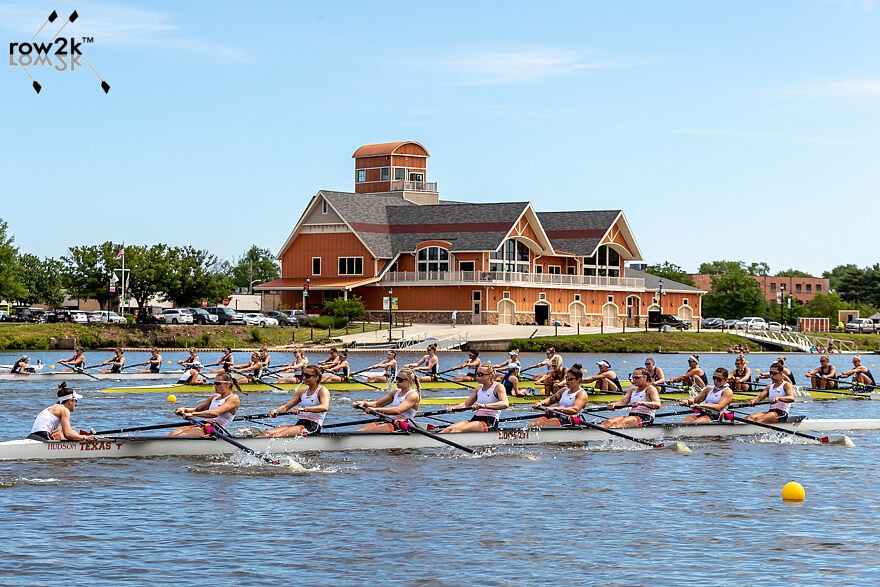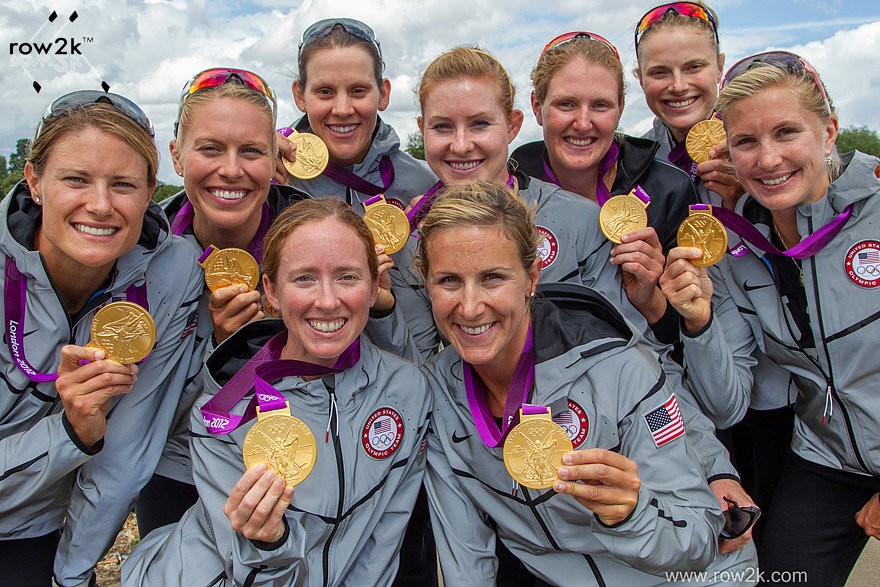In the Driver's Seat, with Cara Burns

Next up In The Driver's Seat--where we hear from the folks who add that extra something to the teamwork of a crew—-is coxswain Cara Burns.
Cara, a sophomore, coxes the 1V Eight at Iowa, after racing with the Varsity Four in her first year as a Hawkeye.
She started coxing as an eighth grader in Pittsburgh, and by the time she finished up at Three Rivers Rowing, she had steered the Youth Four to a win at the Hooch in 2019 and took second in the Youth Eight that same year. She also picked up fourth place in the Youth Four with Three Rivers at the Head of the Charles in 2021.

This week, she will race with her #18th ranked Iowa team at the B1G Ten Championships in hopes of earning a bid to the 2023 NCAA Championships.
Let's hop In The Driver's Seat with Cara:
row2k - What do you see as the three most important things for being a successful coxswain?
Cara Burns - I think that the three most important factors to being a coxswain include a good relationship with both the coach and the rowers, an equal amount of focus and fun, and an in-depth understanding of the sport.
The coach knows what is best for the rowers, but the rowers know what’s going on in their own bodies. Being the middleman between the coach and the rowers and being able to communicate things to both sides is very important. The coach and rowers need to be able to trust you and respect you.
An equal amount of focus and fun is key as it keeps the rowers focused and helps them improve, but you also need to have fun and be positive in the boat to keep them motivated.
In-depth understanding of the sport is necessary as it makes sure your rowers understand what the coaches are saying to them, along with the fact that you need to understand how the boat moves and what makes it move. You are essentially the connection between the coach and the crew, and you need to make sure that the rowers understand how to make the boat move in the way the coach wants. Every coach and every rower is different and it is your job to make them work together as seamlessly as possible.

row2k - What is your favorite drill to run with your crews? Any tips on how to the drill well, for maximum effectiveness?
Cara Burns - My favorite drill to run with my crews is the add-a-pair drill in an eight: you take ten strokes with stern pair, then add in five and six and take ten strokes, and keep adding pairs until you’re at all eight. This drill allows the rowers to feel the connection when it’s just their pair rowing by increasing the force required to open and maintain their pocket of water with the additional weight of the rest of the crew.
To cox this drill well, I would suggest making sure that the rowers are focusing on the part of the drive that your coach emphasizes as having the most connection. On our team, we like to focus on the front end of the stroke. As a result of this, I make sure to communicate the importance of the connection and impulse right off the footboards at the catch. In general, keeping the rowers focused and engaged during drills and ensuring that the rowers understand the drill will always help the drill reach its maximum effectiveness.

row2k - What's some of the best coaching advice you've received about your coxing?
Cara Burns - The best coaching advice I ever received about my coxing was that my tone has a big effect on the boat. It should change depending on what crew I’m with and what workout we’re doing. Some crews respond really well when you fire them up, so you can talk in a louder, sterner tone. With other crews, they might get frantic with loud calls, so you need to be calm with them and keep their heads focused and inside the boat. You also have to remember that if your tone isn’t confident, it will most likely have a negative effect on the rowers and could cause them to worry and get distracted.
Different workouts deserve different tones. You wouldn’t approach coxing a 45-minute steady state the same way you would approach coxing 500 meter pieces. Some pieces might involve sinking your voice into the rhythm of the boat while others require you to speak outside the rhythm of the boat in order to get your point across to your crew. Learning to feel out the mood of the row and knowing your rowers well will aid you in implementing this advice.
row2k - What is a mid-race call or move that you've made that you'll remember for the rest of your life? If so, what did it involve and how did you call it? Cara Burns - At the B1G 10 Invitational last year, I was in the Varsity 4+ and there was one boat in the race that we were determined to beat. We did not want to be the crew that lost to them. We were ahead of the boat by about half a length, but then the boat walked through us and had open water. I was coxing a crew that went fastest when they were fired up, so I told the rowers that this boat had open water on us and told them we had to walk back up immediately. I made a reset call and then a move call following it, and we walked back through their boat to win the race.

Another call that I will remember for the rest of my life was during the B1G 10 Invitational this year in the Varsity 8+. Our boat felt as though we had something to prove, and we were in our first race of the regatta. We were unranked, but we were racing two ranked teams that we felt that we could beat. We were in first place by a meter or two of open water going into the third 500. As a boat we have a very close bond and good chemistry, both on and off the water. Knowing this about my crew, I was able to make a call about how much we love each other and how that makes us unbreakable. Although it sounds mushy and gushy, it worked. We were able to hold our split through the third 500 and win the race by multiple seconds.
row2k - Can you tell us anything about what you've learned about how to call a good start?
Cara Burns - The more starts I did, the more I learned about them. They are my favorite part of the race. Over the years, I have learned that both your choice of words and attitude can really affect how the rest of the race will go. You can always make attempts to reset your crew’s mindsets in the middle of the race, but it’s best to start the race off on a positive note.
Your attitude should reflect whatever your goal for your start is. This means if your goal is to be aggressive during the start, then you should go into it with an aggressive attitude. I have also learned that short words and phrases work best. It is important to stay calm and collected during the start, so I say short things during the strokes to remind the rowers of their technique so that they can stay focused.

row2k - Tell us about the best and worst race/practice you've ever had?
Cara Burns - To me, the outcome of the race isn’t what defines it as good or bad. After a lot of experience, I have learned that it is defined by the satisfaction felt coming off of the water post-race. Some of the best races I have ever had are the ones we didn’t win. Knowing what your crew has accomplished and if you’ve reached your goals lets you know if you had a good or bad race.
In terms of practice, I’ve found that they are best when approached with positive attitudes and the worst are approached with negative attitudes. Practice is a time for the team to learn, and it is much harder to learn in a negative environment. Much more learning happens in positive environments, so the best and most accomplished practices happen with positivity and willingness to change and improve.
Thanks for riding along with Cara -- and, remember, this column is open to all "drivers" out there, so if you are an experienced coxswain at any level--from juniors to masters--and would be willing to invite row2k to join you in your ride, just contact us here. We’d love to hear from you about what you see from the Driver's Seat.

If you enjoy and rely on row2k, we need your help to be able to keep doing all this. Though row2k sometimes looks like a big, outside-funded operation, it mainly runs on enthusiasm and grit. Help us keep it coming, thank you! Learn more.
Comments | Log in to comment |
There are no Comments yet
| |
- Bont Rowing
- Calm Waters Rowing
- Concept 2
- Craftsbury Sculling
- The Crew Classic
- CrewLAB
- Croker
- Dad Vail Regatta
- Durham Boat Co.
- Empacher
- Faster Masters
- Filippi
- Fluidesign
- h2row.net
- HUDSON
- Live2Row Studios
- Nielsen-Kellerman
- Oak Ridge RA
- Peinert Boat Works
- Pocock Racing Shells
- Race1 USA
- Rockland Rowing Masters Regatta
- RowKraft
- Rubini Jewelers
- Vespoli USA
- WinTech Racing
- Bont Rowing
- Calm Waters Rowing
- Concept 2
- Craftsbury Sculling
- The Crew Classic
- CrewLAB
- Croker
- Dad Vail Regatta
- Durham Boat Co.
- Empacher
- Faster Masters
- Filippi
- Fluidesign
- h2row.net
- HUDSON
- Live2Row Studios
- Nielsen-Kellerman
- Oak Ridge RA
- Peinert Boat Works
- Pocock Racing Shells
- Race1 USA
- Rockland Rowing Masters Regatta
- RowKraft
- Rubini Jewelers
- Vespoli USA
- WinTech Racing
















